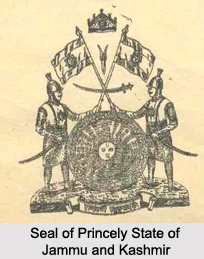 Princely State of Jammu and Kashmir ended its existence in 1947, when Jammu and Kashmir was taken by Indian Government after the Independence of India on 15th of August 1947, from the British Government.
Princely State of Jammu and Kashmir ended its existence in 1947, when Jammu and Kashmir was taken by Indian Government after the Independence of India on 15th of August 1947, from the British Government.
Princely State of Jammu and Kashmir> was served from the British era that is from 1846 until 1952. Princely State of Jammu and Kashmir is a princely state in the British Empire in India, and was ruled by Jamwal Rajput Dogra Dynasty.
Creation of Princely State of Jammu and Kashmir
Princely State of Jammu and Kashmir was created in 1846 after the First Anglo-Sikh War as per the Treaty of Amritsar. The British East India Company annexed the Kashmir Valley, Ladakh, and Gilgit-Baltistan from the Sikhs, and then transferred it to Gulab Singh in return for an indemnity payment of 7,500,000 Rupees.
Early Kashmir Kings of Princely State of Jammu and Kashmir
 The region of Kashmir valley was ruled by the Afghan Durrani Empire from Kabul, until in 1819 it was annexed by the Sikh Empire under Maharaja Ranjit Singh. Jammu was a tributary of the Sikhs Empire at this time. The Raja of Jammu, Kishore Singh, died in 1822; his son Gulab Singh was recognized by the Sikh Empire as his heir. As a vassal of the Sikh Empire, Gulab Singh began expanding his kingdom. He conquered Bhadarwah after a slight resistance. He then annexed Kishtwar after the minister, Wazir Lakhpat, quarrelled with the ruler and sought the assistance of Gulab Singh. The Raja of Kishtwar surrendered without fighting when Gulab Singh`s forces arrived. The conquest of Kishtwar meant that Singh had gained control of two of the roads which led into Ladakh, which then led to the conquest of that territory. Although there were huge difficulties due to the mountains and glaciers, Gulab Singh`s Dogra troop under his general Zorawar Singh Kahluria conquered the whole of Ladakh in two campaigns. A few years later, in 1840, Zorawar Singh invaded Baltistan, captured the Raja of Skardu, who had sided with the Ladakhis, and annexed his country to Gulab Singh`s kingdom. In 1841 Zorawar Singh invaded Tibet, but perished with nearly his entire army in the harsh winter. Whether it was policy or whether it was accident, by 1840 Gulab Singh had encircled Kashmir.
The region of Kashmir valley was ruled by the Afghan Durrani Empire from Kabul, until in 1819 it was annexed by the Sikh Empire under Maharaja Ranjit Singh. Jammu was a tributary of the Sikhs Empire at this time. The Raja of Jammu, Kishore Singh, died in 1822; his son Gulab Singh was recognized by the Sikh Empire as his heir. As a vassal of the Sikh Empire, Gulab Singh began expanding his kingdom. He conquered Bhadarwah after a slight resistance. He then annexed Kishtwar after the minister, Wazir Lakhpat, quarrelled with the ruler and sought the assistance of Gulab Singh. The Raja of Kishtwar surrendered without fighting when Gulab Singh`s forces arrived. The conquest of Kishtwar meant that Singh had gained control of two of the roads which led into Ladakh, which then led to the conquest of that territory. Although there were huge difficulties due to the mountains and glaciers, Gulab Singh`s Dogra troop under his general Zorawar Singh Kahluria conquered the whole of Ladakh in two campaigns. A few years later, in 1840, Zorawar Singh invaded Baltistan, captured the Raja of Skardu, who had sided with the Ladakhis, and annexed his country to Gulab Singh`s kingdom. In 1841 Zorawar Singh invaded Tibet, but perished with nearly his entire army in the harsh winter. Whether it was policy or whether it was accident, by 1840 Gulab Singh had encircled Kashmir.
Princely State of Jammu and Kashmir and First Anglo-Sikh War
 In the winter of 1845, the First Anglo-Sikh War broke out. Gulab Singh remained neutral until the Battle of Sobraon in 1846, when he appeared as a useful mediator and the trusted adviser of Sir Henry Lawrence. The war was ended by two treaties. In the Treaty of Lahore, the Sikh Empire ceded territory to the British East India Company in lieu of part of a large indemnity; this territory included the hill country between the Beas River and Indus River. And from that Princely State of Jammu and Kashmir was regarded as the state for Rajputs till British era.
In the winter of 1845, the First Anglo-Sikh War broke out. Gulab Singh remained neutral until the Battle of Sobraon in 1846, when he appeared as a useful mediator and the trusted adviser of Sir Henry Lawrence. The war was ended by two treaties. In the Treaty of Lahore, the Sikh Empire ceded territory to the British East India Company in lieu of part of a large indemnity; this territory included the hill country between the Beas River and Indus River. And from that Princely State of Jammu and Kashmir was regarded as the state for Rajputs till British era.
Princely State of Jammu and Kashmir in Modern India
In 1947, British Government in India gave up its rule of India. The Indian Independence Act divided British India into two independent states, the Dominion of Pakistan and Dominion of India. According to the Act, the suzerainty of His Majesty over the Indian States lapses, and with it, all treaties and agreements in force at the date of the passing of this Act between His Majesty and the rulers of Indian States. So each of the princely states was free to join India or Pakistan or to remain independent. Most of the princes acceded to one or the other of the two nations.
Related Articles
Jammu and Kashmir, Indian State
Instrument of Accession of Jammu and Kashmir
Culture of Jammu and Kashmir
Costumes of Jammu and Kashmir
History of Jammu & Kashmir
Kashmir






































